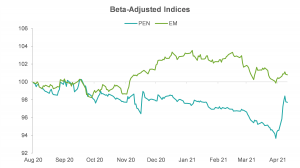Resumo do Relatório
FX Dashboard: Peru’s Currency and Rates Already Reflecting Election Risk
The dollar index (DXY) edged 0.1% lower to 92 as it has retreated to its erstwhile range of 89.5 to 92.5 that persisted from mid-December to mid-March. With the dollar range-bound, EM currencies were flat on the day. There was a fair bit of differentiation within EM though with the Chilean peso (CLP) and the Brazilian real (BRL) appreciating around 0.5% each and the Hungarian forint against the euro (EURHUF) and the Polish zloty against the euro (EURPLN) depreciating around 0.5% each.
Despite the differentiation within EM, few currencies stood out. One of the currencies that need to be watched over the coming weeks is the Peruvian sol (PEN). The first round of the presidential election in Peru produced a surprise outcome with the leftist Pedro Castillo, who was in sixth place in polls a week ago, leading the pack with 19% of the votes. He will be facing Keiko Fujimori in the second round in June.
The extreme-left views of Castillo combined with a rejection rate of above 60% for Fujimori may lead one to conclude that there is significant more downside for the currency and rates. However, we would caution against reaching a hasty conclusion for a few reasons:
- Historically, Peru’s assets have experienced high volatility ahead of elections, only for this volatility to moderate quickly post-elections. The most pertinent presidential elections to mention in this regard are from 2006 and 2011. The leftist Ollanta Humala was viewed very negatively by the market. He ended up losing in the second round in 2006 and won in the second round in 2011, which he followed by nominating an orthodox cabinet and voicing moderate policies. Markets rallied post elections in both cases. This time around, while Castillo is likely to persist with his anti-establishment and populist rhetoric in the campaign as they have worked, it is not a given that his policies will necessarily end up being extreme. Also, in the two months until the second round, he could commit gaffes and lose.
- As the chart below shows and as we discussed in a note a month ago, PEN is already pricing in a high risk premium as the currency has lagged its peers considerably, despite the partial catch-up ahead of the elections. The same is true for Peru’s local rates. Indeed, we showed in a recent note that adjusted for beta, PEN has been the worst performer among EM currencies over the past few weeks.
- Finally, the central bank has sufficient firepower to manage the currency’s volatility. Supported by the rise in metal prices, the country’s terms of trade have improved considerably. Additionally, with global demand rising, export volumes have also increased this year leading to a trade balance of USD 8.8bn in February 2021, the highest since May 2012. Overall, international reserves have jumped by USD 6bn this year to a record USD 80bn.
As such, while on first blush the outcome of the first round appears quite negative, all else equal, we would be inclined to look for an apt entry point to go long the currency before the second round.

Data Source: Refinitiv; Note: EM refers to an index created from equally weighted spot returns for 22 liquid EM currencies
Best Longs / Best Shorts
- On our list of underperformers in the attached FX Dashboard, we replaced the Malaysia ringgit (MYR) with the Israeli shekel (ILS).
- The list already had the Thai baht (THB), the Romanian leu against the euro (EURRON), and the Taiwanese dollar (TWD) on it.
- From our list of outperformers, we removed the Czech koruna against the euro (EURCZK) to leave only the South African rand (ZAR) on it.
Best Crosses
- Our list of preferred relative-value trades still has all pairs with ZAR on the short leg, but the long legs have changed.
- Specifically, we like Short ZAR vs Long THB or ILS or the Indian rupee (INR) or the Indonesian rupiah (IDR).
- The 3m expected returns for these pairs are high as they are in the range of 10.5-12.0% (not annualized), assuming mean reversion.
Aviso legal
DISCLAIMER: Este Relatório de Análise foi elaborado e distribuído pelo Analista, signatário unicamente para uso do destinatário original, de acordo com todas as exigências previstas na Resolução CVM nº 20 de 26 de fevereiro de 2021 e tem como objetivo fornecer informações que possam auxiliar o investidor a tomar sua própria decisão de investimento, não constituindo qualquer tipo de oferta ou solicitação de compra e/ou venda de qualquer produto. As decisões de investimentos e estratégias financeiras devem ser realizadas pelo próprio leitor, os Analistas, ou a OHMRESEARCH não se responsabilizam por elas. Os produtos apresentados neste relatório podem não ser adequados para todos os tipos de investidores. Antes de qualquer decisão de investimentos, os investidores deverão realizar o processo de suitability no agente de distribuição de sua confiança e confirmar se os produtos apresentados são indicados para o seu perfil de investidor. A rentabilidade de produtos financeiros pode apresentar variações e seu preço ou valor pode aumentar ou diminuir num curto espaço de tempo. Os desempenhos anteriores não são necessariamente indicativos de resultados futuros. A rentabilidade divulgada não é líquida de impostos. As informações presentes neste material são baseadas em simulações e os resultados reais poderão ser significativamente diferentes.
O(s) signatário(s) deste relatório declara(m) que as recomendações refletem única e exclusivamente suas análises e opiniões pessoais, que foram produzidas de forma totalmente independente e que a OHMRESEARCH não tem qualquer gerência sobre este conteúdo. As opiniões aqui expressas estão sujeitas a modificações sem aviso prévio em decorrência de alterações nas condições de mercado. O Analista responsável pelo conteúdo deste relatório e pelo cumprimento da Resolução CVM nº 20/21 está indicado acima, sendo que, caso constem a indicação de mais um analista no relatório, o responsável será o primeiro analista credenciado a ser mencionado no relatório. Os analistas cadastrados na OHMRESEARCH estão obrigados ao cumprimento de todas as regras previstas no Código de Conduta da APIMEC para o Analista de Valores Mobiliários e no Manual de Controles Internos para Elaboração e Publicação de Relatórios da OHMRESEARCH. De acordo com o art. 21 da Resolução CVM nº 20/21 caso o Analista esteja em situação que possa afetar a imparcialidade do relatório ou que configure ou possa configurar conflito de interesse, este fato deverá estar explicitado no campo “Conflitos de Interesse” deste relatório.
O conteúdo deste relatório é de propriedade única do Analista signatário e não pode ser copiado, reproduzido ou distribuído, no todo ou em parte, a terceiros, sem prévia e expressa autorização deste Analista. Todas as informações utilizadas neste documento foram redigidas com base em informações públicas, de fontes consideradas fidedignas. Embora tenham sido tomadas todas as medidas razoáveis para assegurar que as informações aqui contidas não são incertas ou equívocas no momento de sua publicação, o Analista não responde pela veracidade das informações do conteúdo.
Para maiores informações, pode-se ler a Resolução CVM nº 20/21 e o Código de Conduta da APIMEC para o Analista de Valores Mobiliários. Este relatório é destinado exclusivamente ao assinante da OHMRESEARCH que o contratou. A sua reprodução ou distribuição não autorizada, sob qualquer forma, no todo ou em parte, implicará em sanções cíveis e criminais cabíveis, incluindo a obrigação de reparação de todas as perdas e danos causados, nos termos da Lei nº 9.610/98 e de outras aplicáveis.





